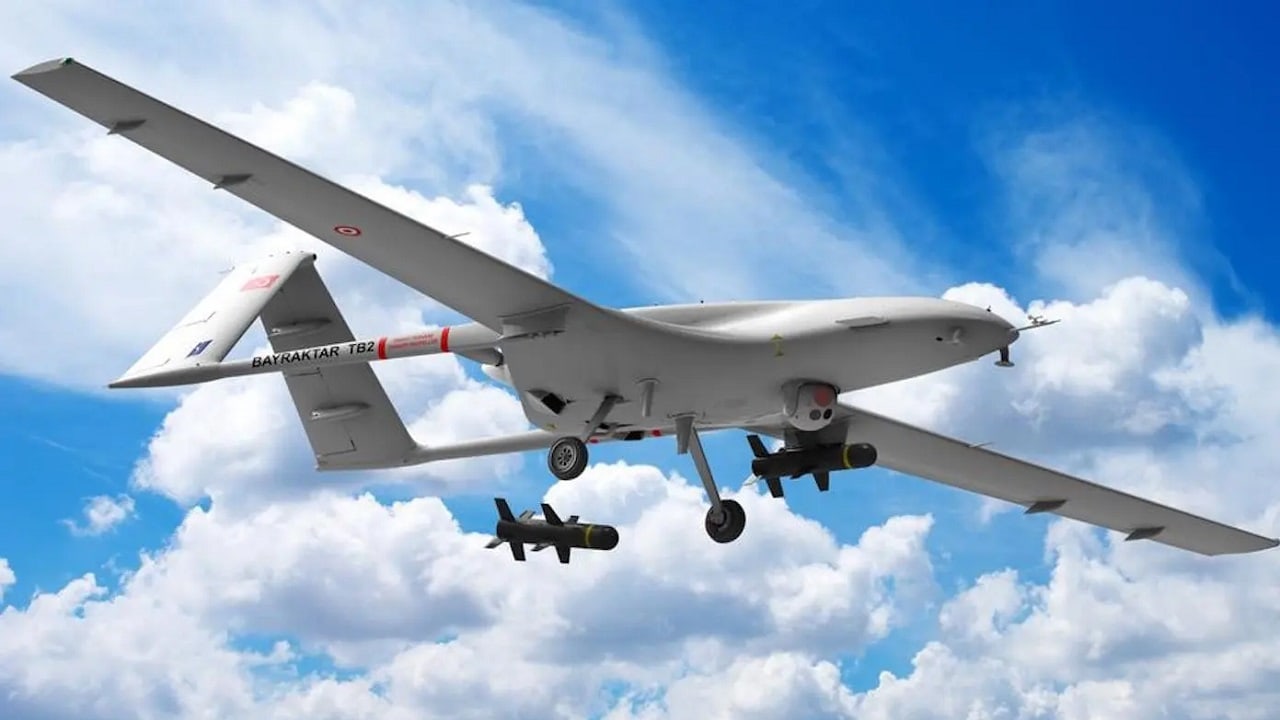Despite the Bayraktar TB2 drone’s acquisition of immense international fame and notoriety in the first months of Russia’s 2022 invasion of Ukraine for the system’s role in harrying Russia’s invasion force, Ukraine has been forced to adapt its use of the Bayraktar TB2 drone as the battle for Ukraine grinds on. While still in significant Ukrainian use, the Bayraktar’s future employment is very much subject to change.
Specs of the Bayraktar
The Bayraktar TB2 is a Medium Altitude Long Endurance armed unmanned aerial vehicle (UAV) designed to collect intelligence, perform surveillance and reconnaissance, and perform air strikes, according to Baykar Technology, the drone’s Turkish manufacturer. Developed in large part by Turkey’s Selçuk Bayraktar, a graduate of MIT and the founder of Baykar Technology, development on the Bayraktar first began in 2007, which was followed by the drone’s first flight in 2009. While the first TB2s were delivered to the Turkish armed forces in 2014, Ukraine would receive its first Bayraktars in 2019.
Despite being propelled by a single engine and propeller, the Bayraktar TB2 is capable of remaining aloft for 27 hours consecutively and has an effective range of 150 kilometers. Depending on its mission, the drone is capable of being fitted with four guided bombs or missiles which can be used to strike a variety of targets weighing a maximum of 150 kilograms, including Russian armored vehicles.
How Has the Bayraktar Performed in Ukraine
The Bayraktar TB2’s worldwide fame can almost entirely be attributed to its performance in Ukraine.
While the system saw use by Turkey in Syria and Libya and was used to significant effect by Azerbaijan during the 2020 Nagorno-Karabakh War, Ukraine’s employment of the drone in its defense against Russia’s invasion has seen a surge in international interest in the system. According to Lt. Col. Yuri Ignat, a spokesman for the Ukrainian Air Force, Ukraine had “approximately” 20 examples of the drone on the eve of the invasion. Since the start of the invasion, Ukraine has received 50 Bayraktar TB2 drones since the start of Russia’s invasion as of late June according to Ukrainian Defense Minister Oleksii Reznikov.
With the ability to carry a wide range of munitions such as MAM-C or MAM-L air-to-ground missiles with armor-piercing, thermobaric, or high-explosive warheads, the Bayraktar’s main strength is its versatility. In Ukrainian service, the Bayraktar has proven capable of both destroying targets itself or targeting other targets on the ground for other Ukrainian weapons or assets to strike. Over the course of Russia’s invasion, Bayraktars have destroyed a variety of Russian artillery, air defense, attack helicopter, armored vehicles, patrol boats, and logistical vehicles according to the independent open-source intelligence blog Oryx, proving itself to be a valuable tool.
Nothing Lasts Forever
However, while Russian forces initially struggled to counter Ukraine’s Bayraktars, battlefield realities have begun to blunt the advantage enjoyed by the Bayraktar.
As the battle for Ukraine has become increasingly concentrated in the Donbas region, so too has Russia’s coverage of its forces with advanced air defenses. According to Ukrainian pilots interviewed by Foreign Policy in June, the use of the system has been cut back as a result of Russia’s overwhelming superiority and coverage of air defenses in the area. While the system has been mostly relegated to safer reconnaissance missions to spot and identify targets for artillery strikes, at least eight examples of the drone have been lost in combat since March.
Nonetheless, there isn’t much a slow-flying tactical drone can conceivably do to circumvent or become otherwise impervious to enemy air defenses, to which the Bayraktar TB2 is no exception. Even as the Bayraktar’s role on the battlefield has been diminished relative to the early days of the invasion, Russian President Vladimir Putin reportedly inquired with Turkish President Recep Tayyip Erdoğan about the possibility of joint production of Bayraktars in Russia, a prospect which Baykar Technology soundly rejected.
While the future use of the Bayraktar will likely see it used in changing ways to provide combat support to Ukrainian forces fighting Russia’s invasion, the drone has already proved its utility in modern, high-intensity combat.
Wesley Culp is a Research Fellow at the Center for the Study of the Presidency and Congress. He regularly writes on Russian and Eurasian leadership and national security topics and has been published in The Hill as well as in the Diplomatic Courier. He can be found on Twitter @WesleyJCulp.

